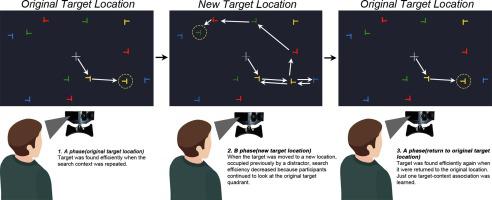Consciousness and Cognition ( IF 2.1 ) Pub Date : 2021-06-19 , DOI: 10.1016/j.concog.2021.103164 Youcai Yang 1 , Mariana V C Coutinho 2 , Anthony J Greene 3 , Deborah E Hannula 3

|
Target detection is faster when search displays repeat, but properties of the memory representations that give rise to this contextual cueing effect remain uncertain. We adapted the contextual cueing task using an ABA design and recorded the eye movements of healthy young adults to determine whether the memory representations are flexible. Targets moved to a new location during the B phase and then returned to their original locations (second A phase). Contextual cueing effects in the first A phase were reinstated immediately in the second A phase, and response time costs eventually gave way to a repeated search advantage in the B phase, suggesting that two target-context associations were learned. However, this apparent flexibility disappeared when eye tracking data were used to subdivide repeated displays based on B-phase viewing of the original target quadrant. Therefore, memory representations acquired in the contextual cueing task resist change and are not flexible.
中文翻译:

上下文提示不灵活
当搜索显示重复时,目标检测会更快,但引起这种上下文提示效应的记忆表征的属性仍然不确定。我们使用 ABA 设计调整了上下文提示任务,并记录了健康年轻人的眼球运动,以确定记忆表征是否灵活。目标在 B 阶段移动到一个新位置,然后返回到它们的原始位置(第二个 A 阶段)。第一个 A 阶段的上下文提示效应在第二个 A 阶段立即恢复,响应时间成本最终让位于 B 阶段的重复搜索优势,这表明学习了两个目标 - 上下文关联。然而,当使用眼动追踪数据根据原始目标象限的 B 相视图细分重复显示时,这种明显的灵活性就消失了。因此,在上下文提示任务中获得的记忆表征抵抗变化并且不灵活。











































 京公网安备 11010802027423号
京公网安备 11010802027423号